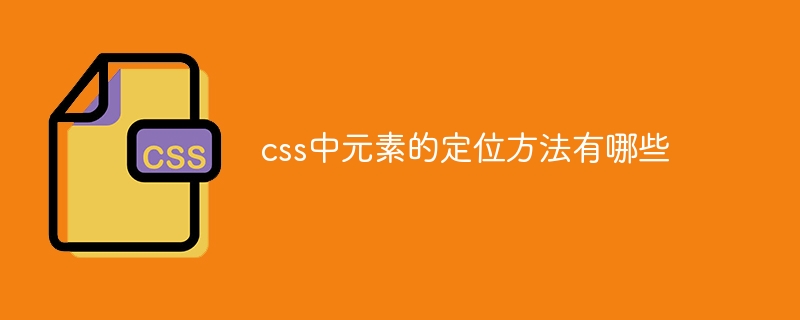What are the positioning methods of elements in css
Apr 26, 2024 am 11:33 AMIn CSS, there are five ways to position elements, including: Static positioning: Default positioning, the element occupies the normal flow position on the page. Relative positioning: Positioned relative to the current position of the element, out of the document flow but without affecting other elements. Absolute positioning: Positioned relative to the containing element, out of the document flow, affecting other elements. Fixed positioning: Positioned relative to the viewport, does not affect other elements, and maintains a fixed position when scrolling. Sticky positioning: It has both relative and fixed positioning characteristics, and the position is fixed when scrolling to the specified position.

Positioning methods of elements in CSS
In CSS, positioning elements are useful for creating specific layouts and control elements. Position on the page is crucial. There are several positioning methods available, each with its own unique uses and advantages:
1. Static positioning(static)
- Default positioning method , the element occupies its normal flow position on the page. The
- element does not break out of the document flow and is therefore not affected by other elements.
2. Relative positioning (relative)
- Position an element relative to its current position in the normal flow.
- Move elements using the
top,right,bottomandleftattributes. The - element is taken out of the document flow but creates space around other non-positioned elements.
3. Absolute positioning (absolute)
- Position the element based on the position of the containing element.
- Use the
top,right,bottomandleftproperties to move an element from its normal flow. The - element is separated from the document flow and will not affect other elements.
4. Fixed positioning (fixed)
- Positions the element relative to the viewport, not its containing elements.
- Use the
top,right,bottomandleftattributes to anchor an element to a specific position in the browser. - When the user scrolls the page, the element remains in the same position.
5. Sticky positioning (sticky)
- combines the characteristics of relative and fixed positioning.
- When an element scrolls to the top or bottom of its containing element, it remains fixed in that position.
- Set the sticky borders of an element using the
top,right,bottomandleftproperties.
Choose a positioning method
Choosing the correct positioning method depends on the specific needs:
- Static positioning is used for elements where A situation with a fixed position in the document flow.
- Relative positioning is used when slight adjustments to elements are required.
- Absolute positioning is used when an element needs to be completely removed from its normal flow.
- Fixed positioning is used when you need to keep an element at a specific position on the screen.
- Sticky positioning is used when an element needs to be fixed when it is scrolled to a specific position.
The above is the detailed content of What are the positioning methods of elements in css. For more information, please follow other related articles on the PHP Chinese website!

Hot Article

Hot tools Tags

Hot Article

Hot Article Tags

Notepad++7.3.1
Easy-to-use and free code editor

SublimeText3 Chinese version
Chinese version, very easy to use

Zend Studio 13.0.1
Powerful PHP integrated development environment

Dreamweaver CS6
Visual web development tools

SublimeText3 Mac version
God-level code editing software (SublimeText3)

Hot Topics
 What language is the browser plug-in written in?
May 08, 2024 pm 09:36 PM
What language is the browser plug-in written in?
May 08, 2024 pm 09:36 PM
What language is the browser plug-in written in?














